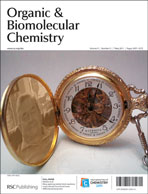Microfluidic technology has been used to perform [11C]carbonylation reactions using solutions containing [11C]CO in the form of the complex, copper(I)tris(3,5-dimethylpyrazolyl)borate-[11C]carbonyl (Cu(Tp*)[11C]CO). The synthesis of the model compound [11C]N-benzylbenzamide and the known tracer molecule [11C]trans-N-[5-(2-flurophenyl)-2-pyrimidinyl]-3-oxospiro[5-azaisobenzofurane-1(3H),1′-cyclohexane]-4′-carboxamide ([11C]MK-0233), a ligand for the neuropeptide Y Y5 receptor, have been performed using this technique. Following semi-preparative HPLC purification and reformulation, 1262 ± 113 MBq of [11C]MK-0233 was produced at the end of the synthesis with a specific activity of 100 ± 30 GBq μmol−1 and a >99% radiochemical purity. This corresponds to a decay corrected radiochemical yield of 7.2 ± 0.7%. Using a 3 mL vial as the reaction vessel, and following semi-preparative HPLC purification and reformulation, 1255 ± 392 MBq of [11C]MK-0233 was produced at the end of the synthesis with a specific activity of 100 ± 15 GBq μmol−1 and a >99% radiochemical purity. This corresponds to a decay corrected radiochemical yield of 7.1 ± 2.2%.
![Graphical abstract: Microfluidic reactions using [11C]carbon monoxide solutions for the synthesis of a positron emission tomography radiotracer](/en/Image/Get?imageInfo.ImageType=GA&imageInfo.ImageIdentifier.ManuscriptID=C0OB00631A&imageInfo.ImageIdentifier.Year=2011)
You have access to this article
 Please wait while we load your content...
Something went wrong. Try again?
Please wait while we load your content...
Something went wrong. Try again?
![Graphical abstract: Microfluidic reactions using [11C]carbon monoxide solutions for the synthesis of a positron emission tomography radiotracer](/en/Image/Get?imageInfo.ImageType=GA&imageInfo.ImageIdentifier.ManuscriptID=C0OB00631A&imageInfo.ImageIdentifier.Year=2011)

 Please wait while we load your content...
Please wait while we load your content...